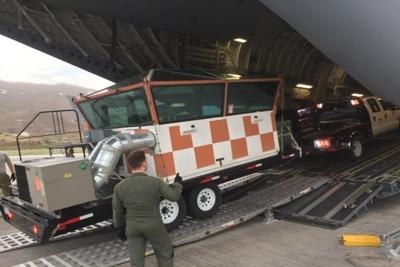Updates Information For Pilots And Drone Users In The Wake Of Hurricane Irma
In the wake of Hurricane Irma’s destructive path through the Caribbean, the Federal Aviation Administration (FAA) is supporting storm recovery efforts in the U.S. Virgin Islands with a fully-staffed mobile air traffic control tower at Cyril E. King International Airport in St. Thomas. The tower was fully operational at 9:40 a.m. Wednesday morning and is now supporting relief flights by the U.S. military, the Federal Emergency Management Agency, general aviation and limited commercial flights.

The existing air traffic control tower at the airport was badly damaged by the storm, and controllers were managing air traffic from a tent on the airfield for several days before the mobile tower arrived this morning. The FAA is shuttling controllers back and forth from San Juan, Puerto Rico to St. Thomas every day to staff the facility.
A U.S. Air Force C17 airlifted the tower from Boise, Idaho, to St. Thomas, along with a custom-made trailer and a truck to unload it. The tower is equipped with an engine generator, an air conditioner, four radios for the air traffic controllers and instruments to measure barometric pressure, as well as wind speed and direction. The tower arrived in St. Thomas at 6:15 a.m. and was fully operational in three hours and 25 minutes.
In addition to the air traffic controllers, the FAA has an airport certification inspector on site at St. Thomas to ensure the airport is safe before air carrier operations resume. He is working closely with the Virgin Islands Port Authority to ensure that its operation is stabilized, airport safety procedures are in place, all hazards are mitigated and the airport is fully compliant with federal regulations, so recovery efforts can expand and continue.
Airports and associated facilities including terminal buildings, parking lots and access roads are operated by local organizations that decide when to close to commercial operations and when they can safely reopen. The FAA does not decide if or when airports or other local facilities close or reopen. Some airports in a disaster area may stay closed to the public for several days in the wake of a storm to support the response and recovery effort or because roads to and from the airport are inaccessible. FAA air traffic controllers always are ready to safely resume air traffic control service when airports reopen, and frequently are managing air traffic operations for response and recovery flights while airports are closed to the general public.
Commercial Travelers
Due to Hurricane Irma, airlines are likely to cancel many flights in the direct path of the storm and the surrounding area. Flights that are not cancelled may be delayed. Please continue to check the status of your flight with your airline. You can also check the status of some major airports in the storm path by visiting Fly.FAA.gov, which is continuously updated.
Drone Users
As of Wednesday, the FAA had issued 138 authorizations to commercial drone operators to support Hurricane Harvey relief efforts, with 24 still active. The FAA has issued 80 authorizations for Hurricane Irma recovery, 44 of which are active.
Government agencies with an FAA Certificate of Authorization (COA) and private sector Part 107 drone operators who want to fly to support of response and recovery operations are strongly encouraged to coordinate their activities with the local incident commander responsible for the area in which they want to operate.
If UAS operators need to fly in controlled airspace or a disaster TFR to support the response and recovery, operators must contact the FAA’s System Operations Support Center (SOSC) by emailing 9-ATOR-HQ-SOSC@faa.gov to determine the information they need to provide in order to secure authorization to access the airspace. Coordination with the SOSC may also include a requirement that the UAS operator obtain support from the appropriate incident commander. The FAA may require information about the operator, the UAS type, a PDF copy of a current FAA COA, the pilot’s Part 107 certificate number, details about the proposed flight (date, time, location, altitude, direction and distance to the nearest airport, and latitude/longitude), nature of the event (fire, law enforcement, local/national disaster, missing person) and the pilot’s qualification information.
The FAA warns unauthorized drone operators that they may be subject to significant fines if they interfere with emergency response operations. Many aircraft that are conducting life-saving missions and other critical response and recovery efforts are likely to be flying at low altitudes over areas affected by the storm. Flying a drone without authorization in or near the disaster area may unintentionally disrupt rescue operations and violate federal, state, or local laws and ordinances, even if a Temporary Flight Restriction (TFR) is not in place. Allow first responders to save lives and property without interference.
General Aviation Pilots
General aviation pilots should check the FAA’s Notices to Airman (NOTAMs) before flying and review the latest information on flight restrictions in the areas affected by Hurricane Irma. You can monitor TFRs at TFR.FAA.gov and @FAANews on Twitterfor the latest information. Regardless of where you are flying, always be aware of the weather conditions along your entire planned route. Contact your destination airport before you take off to obtain the most current information about local weather and airfield conditions. Remember that standard check lists are even more important in and around severe weather. Be aware of weather conditions throughout the entire route of your planned flight. A pilot’s failure to recognize deteriorating weather conditions continues to cause or contribute to accidents.
(Source: FAA news release)
 ANN's Daily Aero-Linx (04.16.24)
ANN's Daily Aero-Linx (04.16.24) Aero-News: Quote of the Day (04.16.24)
Aero-News: Quote of the Day (04.16.24) Airborne 04.10.24: SnF24!, A50 Heritage Reveal, HeliCycle!, Montaer MC-01
Airborne 04.10.24: SnF24!, A50 Heritage Reveal, HeliCycle!, Montaer MC-01 Airborne 04.12.24: SnF24!, G100UL Is Here, Holy Micro, Plane Tags
Airborne 04.12.24: SnF24!, G100UL Is Here, Holy Micro, Plane Tags Airborne-Flight Training 04.17.24: Feds Need Controllers, Spirit Delay, Redbird
Airborne-Flight Training 04.17.24: Feds Need Controllers, Spirit Delay, Redbird



